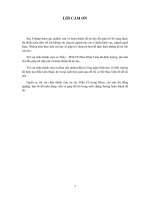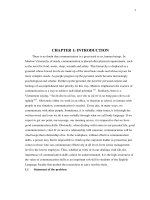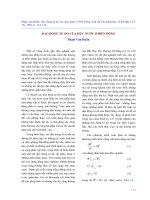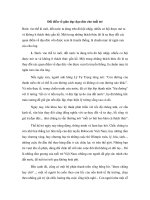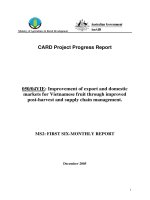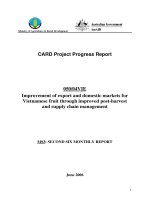Báo cáo nghiên cứu khoa học: "POWER AMPLIFIER MODELING AND POWER AMPLIFIER PREDISTORTION IN OFDM SYSTEM" docx
Bạn đang xem bản rút gọn của tài liệu. Xem và tải ngay bản đầy đủ của tài liệu tại đây (395.13 KB, 9 trang )
TẠP CHÍ PHÁT TRIỂN KH&CN, TẬP 11, SỐ 02 - 2008
Trang 33
POWER AMPLIFIER MODELING AND POWER AMPLIFIER
PREDISTORTION IN OFDM SYSTEM
Tran Duc Tan
College of Technology, VNU- HN
(Manuscript Received on August 30
th
, 2006, Manuscript Revised December 05
th
, 2007)
ABSTRACT: This paper presents a baseband predistorter to be used in OFDM systems
operating with a nonlinear high power amplifier (HPA). Key features of the predistorter reside
in the use of the HPA inverse structure as nonlinear distortion compensator. The performance
of the compensated system is analyzed by simulations in an AWGN environment. The receiver
also needs furthermore an equalizer in order to combat the distorsion effect.
Keywords: OFDM, DAP, HPA, Adaptive Equalizer
1. INTRODUCTION
Nowadays, the OFDM technology is applied widely in the wireless communication
because of many advantages such as robustness to severe multipath channels compared to
single carrier (SC) system; effective bandwidth to FDM systems; and transceiver structures
simple (based on DFT circuits) [1], [2].
However, in ODFM Systems, we can not ignore a distorsion problem introduced by
nonlinear High Power Amplifier (HPA) [3], [4].The main purpose of our paper is to analyze
these effects on a high speed OFDM system (WLAN2) [5]. Then, it is focused on designing a
Digital Adaptive Pre-distorter (DAP) to overcome the nonlinear effect of HPA.
2. SYSTEM DESCRIPTION
Figure 1 shows the baseband equivalent system of an OFDM system [5]. The input of the
system is a serial of binary data, mapped onto the M-ary QAM signal constellation to give a
stream of complex symbols which are assumed to be statiscally independent. This complex
symbol stream is applied to the OFDM modulation block. In the OFDM block, the stream is
serial-to-parallel converted to produce a sequence
k
c
.
k
c
is transformed by a inverse fast
Fourier transform (IFFT) unit. A guard interval called cyclic prefix (CP) with length
g
T
is
added to this signal, yielding a T-spaced discrete-time representation of the transmitted signal.
The nth transmitted OFDM block is given by:
∑
−
=
−=
1
0
)(
1
)(
N
k
nkn
nTtc
N
ts
φ
(1)
where
othersiwe 0
],[ ),2exp(
)(
⎩
⎨
⎧
−∈∀⋅⋅⋅
=
TTttfj
t
gk
k
π
φ
(2)
Science & Technology Development, Vol 11, No.02- 2008
Trang 34
Fig 1. Baseband equivalent of the OFDM system.
where N is the number of the subcarriers.
u
k
T
k
ff
+=
0
and
0
0
=
f
.
The modulated signal
)(tx
is first pre-distorted and then nonlinearly amplified, and finally
propagating over a AWGN channel.
The TWT Amplifier model given in [3], [6] is used for a nonlinear HPA.
[
]
))((exp)()(
ρθρ
yByjyAtz +⋅=
(3)
where
ρ
y
and
θ
y
are the amplitude and phase of the complex signal.
The function
(.)A
and
(.)B
denote AM/AM conversion (non-linear amplitude) and
AM/PM conversion (non-linear phase) respectively, and are given by:
2
1
2
)(
ρ
ρ
ρ
y
y
yA
+
⋅
=
(4)
6
1
2
)(
2
2
π
ρ
ρ
ρ
⋅
+
⋅
=
y
y
yB
(5)
The non-linear distortion of a TWT amplifier (TWTA) depends on the back-off. The input
back-off (IBO) and the output back-off (IBO) for the amplifier are defined as
⎥
⎦
⎤
⎢
⎣
⎡
−−−=
⎟
⎟
⎠
⎞
⎜
⎜
⎝
⎛
=
)
2
exp(1log10
log10
2
2
max
10
,
,
10
σ
R
IBOOBO
P
P
IBO
iavg
isat
(6)
where
isat
P
,
is the saturation input power and
iavg
P
,
is the average input power of the
TWTA.
Figure 2 shows the Saleh model (a typical HPA) written in SIMULINK. Figure 3 gives the
AM/AM and AM/PM characteristics of this model.
TẠP CHÍ PHÁT TRIỂN KH&CN, TẬP 11, SỐ 02 - 2008
Trang 35
Fig 2. Saleh model
Fig 3. AM/AM and AM/PM characteristics of the Saleh model.
At the receiver, the received signal is passed through receiver filter and then sampled. The
data samples are serial to parallel converted, and applied to the remove guard and FFT
Science & Technology Development, Vol 11, No.02- 2008
Trang 36
processor. The guard interval is removed and only the time interval
],0[ T
is evaluated and the
output signal is converted back to a serial data sequence and demodulated.
3. ADAPTIVE PREDISTORTER
The predistorsting technique, often called linearization, is a known solution to combat the
nonlinear effect of HPA [7], [8], [9]. It consists of inverting the HPA nonlinearity
characteristic. In this paper is considered an adaptive predistorter of which the action is to
linearize the operation of a nonlinear HPA. The principle of this technique is shown in Figure
4.
Fig 4. Baseband model of the precompensator
As mentioned in section 2 (Equ. 3),
(.)A
and
(.)B
denote the amplitude and phase transfer
function of the HPA,
θ
ρ
yj
ey
⋅
is the complex envelope of the input signal. If we add
predistorter before the HPA, the output of the predistorter is expressed as:
))))((.(exp())((
tyyjtyFz
PPd
ψ
θ
+=
(7)
Ideally, we want to see the result as belows after predistorter:
0)))((())((
)(.)))(((
=+
=
tyFBty
tytyFA
PP
PP
ψ
α
(8)
The inverse function can be approximated by a polynomial expansion series of yP.
ψ
ψψψψψ
RPyyyy
RVyfyfyfyF
TM
PMPPP
f
TL
PLPPP
=++++=
=+++=
)(
)(
2
210
2
21
(9)
where
TẠP CHÍ PHÁT TRIỂN KH&CN, TẬP 11, SỐ 02 - 2008
Trang 37
T
M
T
L
TM
PPP
TL
PPPf
V
fffV
yyyR
yyyR
], ,,[
], ,,[
], ,,[
], ,,[
10
21
2
2
ψψψ
ψ
=
=
=
=
The optimal coefficients V and P are determined by using Least Mean Square (LMS)
algorithm:
)))((()(
2
1 f
T
P
RVAyEVJ −=
α
(10)
And the updated values of V and P are:
)
,
))(()(
,
('
,1
))()(
,
('
,1
k
R
T
k
P
P
yFB
k
R
T
k
VB
k
R
k
P
k
P
f
R
T
VA
P
y
kf
R
T
k
VA
kf
R
vk
V
k
V
ψψψψ
μ
αμ
−−+=
+
−+=
+
(11)
A’(.) and B’(.) are the derivatives of A(.) and B(.) respectively.
At first, it was intended to use one sole device, namely an equalizer, to prevent
simultaneously combat the HPA nonlinearity effect and the AWGN effect. But it leads to a
very complex structure for the equalizer. Therefore a trade-off is made by introducing a PD to
take care of the HPA nonlinearity and an simple equalizer to compensate the AWGN channel
effect.
As mentioned in section 2 (Equ. 3), we assume that h(n) is the discrete response of the
channel. The received sample can be expressed as:
)()()()( ndnhnxny +×=
(12)
With the help of the CP, Equ. (12) can be expressed in frequency domain as:
)()()()( zDzHzXzY +=
(13)
To compensate the channel effects, a FIR linear equalizer with transfer function C(z) is
used to estimate the signal X(z):
)()()()()()()()( zDzCzHzXzCzYzCzX +==
)
(14)
This equalizer is added between demapping block and the OFDM demodulator as shown
in Figure 5. In this structure, the pilot driven 1-tap LMS algorithm is employed in order to
obtain a fast response. In the OFDM modulation block, first of all, a fixed number of pilots is
introduced into the data frame. At the ODFM demodulation block, this noisy pilot bit is spitted
and fed to LMS block in order to determine the information about the channel characteristics.
The errors are calculated by:
)),(
ˆ
(),(
ˆ
),( kjXkjXkje Π−=
(15)
where
),(
ˆ
( kjXΠ
denotes the decision, k refers to sub-carrier order, j is time index. Error
sequence is then used to adjust the equalizer coefficients, based on the LMS algorithm.
),(),(2
),(
),(
*
2
kjYkje
kjC
kje
=
∂
(16)
Thus the tap gain is adjusted according to:
Science & Technology Development, Vol 11, No.02- 2008
Trang 38
),(),(),(),1(
*
kjYkjekjCkjC Δ−=+
(17)
where ∆ is pilot constant.
Fig 5. LMS equalizer
4. SIMULATION RESULTS
The effects of nonlinearity on the received 16-ary QAM constellations are shown in Figure
6, Figure 7 and Figure 8 which correspond to the ideal system, AWGN channel system and
HPA system, respectively. In the ideal case, there are 16 well defined points. In the unideal
cases, the received cloud is characteristic to the AM/AM - PM/AM nonlinearities and the
AWGN channel.
Fig 6. Received 16-ary QAM constellation with the ideal system
Fig 7. Received 16-ary QAM constellation with the AWGN channel
TẠP CHÍ PHÁT TRIỂN KH&CN, TẬP 11, SỐ 02 - 2008
Trang 39
Fig 8. Received 16-ary QAM constellation with the Saleh model (HPA at OBO = 4.6 dB)
5
th
order polynomials are adopted to approximate the AM/AM conversion characteristic of
the Saleh model. Figure 9 illustrates the convergence of coefficients of the predistorter.
Fig 9. Convergence of coefficients in amplitude predistorter
To demonstrate the performance of the proposed linearization system, we evaluated the Bit
Error Rate (BER) using Monte Carlo simulation for systems with the PD and Adaptive
Equalizer. For comparison purpose, we also show the performance for systems without
linearizers and system with ideal channels.
The simulations are carried out for a OFDM system with 192 subscribers and 16-ary QAM
signaling on each subcarrier for 3 different scenarios listed in Table 1. Figure 10 shows the
BER in term of SNR, varying between 0 and 18 dB.
Table 1. Five schemes in the proposed OFDM system
Scheme No. Nonlinearity Performance
1 HPA & AWGN noise Un-PD & un-EQ
2 AWGN noise EQ
3 HPA & AWGN noise PD & EQ
Science & Technology Development, Vol 11, No.02- 2008
Trang 40
Fig 10. BER vs. SNR for the OFDM system OBO = 5 dB
The results of the 1
st
shows the severe impact of AWGN noise channel and HPA effects.
It’s very interesting to observe that both the 2
nd
scenario and the 3
rd
have nearly the same
BER. This result agrees with the convergence of coefficients in the predistorter.
5.CONCLUSION
Due to large envelope variations, the distortion introduced by nonlinear HPA is more
obvious in OFDM systems. In this paper two compensation methods are combined and
studied: adaptive predistorter to combat HPA and adaptive equalizer to combat the AWGN
channel. The PD can reduce most of the out-band noise caused by HPA, while the eualizer
LMS algorithm converges slowly. The performance of the compensated system tremendously
enhanced. The next step of this work will consider other approaches to accelerate he adaptive
equalizer convergence, such as ZF, RLS.
MÔ HÌNH HOÁ BỘ KHUẾCH ĐẠI CÔNG SUẤT VÀ BỘ DỰ ĐOÁN MÉO
TRONG HỆ THỐNG OFDM
Trần Đức Tân
Trường Đại học Công nghệ, ĐHQG-HN
TÓM TẮT: Công nghệ điều chế số đa sóng mang trực giao (OFDM) đang được ứng
dụng ngày càng rộng rãi trong lĩnh vực truyền thông không dây. Tuy nhiên các hệ thống
OFDM lại chịu tác động rất lớn bởi hiện tượng phi tuyến gây ra bởi các bộ khuếch đại công
suất cao. Hệ thống được mô phỏng trên kênh truyền có nhiễu trắng cộng tính (AWGN). Thuật
toán thích nghi đã được sử dụng để thiết kế mộ
t bộ dự đoán méo và một bộ cân bằng nhằm
loại bỏ các yếu tố phi tuyến này.
TẠP CHÍ PHÁT TRIỂN KH&CN, TẬP 11, SỐ 02 - 2008
Trang 41
REFERENCES
[1]. J.A.C. Bingham, Multicarrier modulation for data transmission: an idea whose time
has come, IEEE Comm. Mag., Vol. 28, Nº 5, pp. 5-14, (1990).
[2].
Jakes W. C., Microwave Mobile Communications, New York, Wiley, (1974).
[3].
K. Haider, H.S Al-Raweshidy, Phase noise effect on hiperLAN/2 system
performance,
The 5th International Symposium on Wireless Personal Multimedia
Communications, Vol. 3, 2002, pp. 1010 –1014, (2002).
[4].
A.hravan and T. Eriksson, PAPR and other measures for OFDM systems with
nonlinearity, The 5th International Symposium on Wireless Personal Multimedia
Communications, pp. 149-153, (2002).
[5].
[5] J. Heiskala and J. Terry, OFDM Wireless LANs: A Theoretical and Practical
Guide, SAMS, (2002).
[6].
[6] Adel A and M. Saleh, Frecuency-Independent and Frecuency-Dependent
Nonlinear Models TWT Amplifiers, IEEE Trans. Communicayion, Vol. COM-29, No.
11, pp. 1715-1719, (1981).
[7].
[7] D. Dardari, V. Tralli, and A. Vaccari; A Theoretical Characterization of
Nonlinear Distortion Effectis in OFDM Systems, IEEE Trans. Communications, Vol.
48, No. 10, pp. 1755-1764, (2000).
[8].
[8] Rodriguez, N., Soto, I., Carrasco, R .A., Adaptive pre-distortion of COFDM
signals for a mobile satellite channel , International Journal of Communication
Systems, (2002).
[9].
[9] W.G. Jeon, K. H. Chang, and Y.S. Cho, An adaptive data predistorter for
compensation of nonlinear distortion in OFDM systems, IEEE Trans.
Communication, Vol. 45, No. 10, pp. 1167-1171, (1997).

